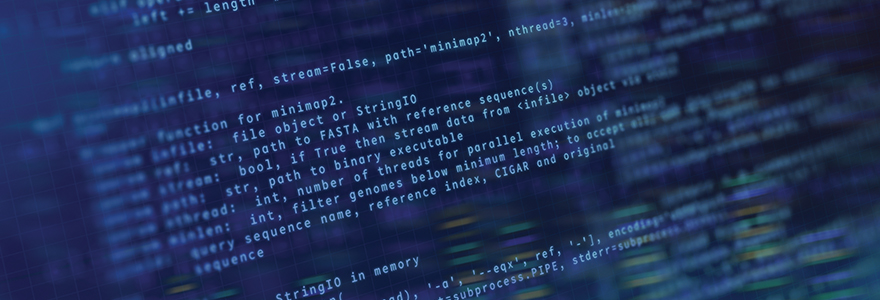Computing the future of medicine

A trio of researchers are leading the way with medical bioinformatics research and developing new tools to convert data into medical knowledge
By Ashley Rabinovitch
In early 2021, Schulich Medicine & Dentistry’s first medical bioinformatics program emerged at a unique moment in time. The rise of Big Data has opened new frontiers of possibility for understanding the biological mechanisms of complex diseases, and a small but passionate group of global researchers is hard at work developing computational tools to convert raw data into medical knowledge.
Three of them call the School home.
For Art Poon, PhD, Associate Professor, Pathology and Laboratory Medicine, the School’s “clear commitment to building capacity for bioinformatics research and education” was a primary motivator for accepting a teaching and research position.
“Building a bioinformatics program has become more urgent with time,” he reflected. “Now that we have data and technology to understand mechanisms of disease, we can understand what is happening at a basic molecular and cellular level. That makes all the difference.”
The bioinformatics research conducted in the Poon Lab involves designing and implementing new computational methods to reconstruct the spread and mutation of viruses from their genetic sequence variation. By using a blend of mathematical modelling, open-source software development, pattern recognition, and high-performance computing, Poon and his colleagues are making progress on analyzing genomes for viruses like HIV, Hepatitis B and SARS-CoV-2.
Poon’s work has taken on new relevance as SARS-CoV-2 mutations continue to wreak havoc around the globe. “By building new tools to analyze the growing mountain of genome data, we can analyze and track the spread of these mutations in different populations,” he said.
“Single-cell sequencing is revolutionizing our understanding of cancer.”
— Parisa Shooshtari, PhD
The second inaugural member of the medical bioinformatics program, Parisa Shooshtari, PhD, Assistant Professor, Pathology and Laboratory Medicine, shares Poon’s passion for genomics. Her lab develops a wide range of computational, statistical, and machine-learning methods to understand cellular and molecular mechanisms underlying complex disease. These days, she spends a good portion of her time developing machine-learning methods for the analysis of single-cell sequencing data.
“Even 10 years ago, researchers in my field had to analyze thousands of cells in bulk to sequence DNA, but the recent advances in next-generation sequencing give us the capability to have measurements at the single-cell level,” she explained.
In collaboration with Princess Margaret Cancer Centre and The Hospital for Sick Children, Shooshtari is working to develop effective machine-learning methods to analyze RNA expressions of individual cells in the data from cancer patients, which can provide insight into the specific cell compositions and mutations in the tumours.
“Single-cell sequencing is revolutionizing our understanding of cancer,” she said. “Ultimately, it reveals differences between patients that will inform the best course of treatment.”
A number of research labs around the world have begun to develop computational methods to analyze single-cell, RNA-seq data with varying degrees of success. Shooshtari is currently undertaking a research project to determine the most effective approaches to analyze these data.
“We want to ensure that the data science approaches being applied to a wide range of cancer types are both comprehensive and effective,” she said. “Eventually, we want to apply our methods to single-cell sequencing data from patients to uncover the biological mechanisms underlying the disease.”
Christina Castellani, PhD’15, the third member of the trio that is pioneering the new medical bioinformatics program, joined the faculty as an Assistant Professor at the beginning of 2021. Her lab focuses on the relationship between the epigenome – modifications to DNA sequence that determine whether genes are switched on or off – and the environment.
“The genome we are born with combines with chemicals, drugs, diets and other environmental components to influence complex disease,” she explained. “My interest lies in using large-scale human cohorts to understand these epigenetic and transcriptomic changes.”
Castellani is developing a series of optimized regression models to draw a connection between mitochondrial DNA and cardiovascular disease. Using genome editing techniques in the lab, she can modify the amount and quality of mitochondrial DNA to see the resulting epigenetic changes in real-time, as well as examine the impact of environmental disruptions like Aspirin and beta blockers.
“At least in part, I’ve been able to add to a growing body of evidence that the environment affects mitochondria, which affects the nuclear epigenome, which affects complex disease,” she said. By using DNA samples from a large group of volunteers over a multi-year study, Castellani aims to use mitochondrial and epigenetic profiles to predict heart disease well in advance and develop potential treatments.
Long term, Castellani’s dream is to bring together knowledge in computer programming, statistics, and genomics for students and researchers at the School.
“Having earned my bachelor’s, master’s and doctoral degrees here at Western, I’m passionate about introducing students to medical bioinformatics,” she said. “While plenty of research groups at Western are focused on bioinformatic approaches to research, Parisa, Art, and I are committed to developing and using computational tools for the purpose of advancing medical research.”
According to Poon, the most formidable challenge he and his colleagues face is the sheer volume of data to process. “It’s enormous and growing exponentially,” he said. “We’re off to a good start, but the more people we can recruit to help build the next generation of tools, the faster we’ll make progress.”








